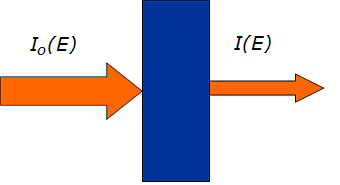2.6 Interactions of x-rays with matter
The main interactions of x-rays with matter include photo electric absorption, incoherent (Compton) and coherent (Rayleigh) scattering. Diffraction can occur when the atoms have a periodic orientation. Each of the interactions has a certain probability to occur, defined as the collision cross section per atom or per electron of the impinged material. The total collision cross section per atom per square centimetre of area normal to the direction of the beam path varies with the energy of the photon and is expressed as:

where τ, σC and σR refer to the cross sections for photoelectric absorption, Compton and Rayleigh scattering, respectively.
The attenuation coefficient can be calculated for each centimetre of travel path X
(μ* - linear attenuation coefficient) or for the unit of areal density encountered (μ mass attenuation coefficient):


Therefore, the total attenuation of the x-rays depends on their energy and the sample composition, and is exponentially proportional to the attenuation coefficient and the amount of mass encountered.

